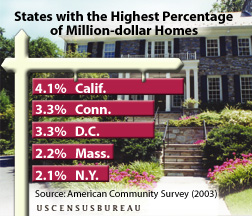
FOR IMMEDIATE RELEASE |
|||
| CB05-AC.54 | |||
| Stephen Buckner | |||
| Public Information Office | Ranking tables [PDFs] | ||
| (301) 763-3691/457-3670 (fax) | State | County | Place | ||
| (301) 457-1037 (TDD) | Million-dollar homes [PDFs] | ||
| e-mail: <pio@census.gov> | by percent | by number | ||
Median Housing Values Continue to Rise, Census Bureau Reports |
|||
Percentage
of Million-Dollar Homes Nearly Doubles Since 2000 |
|||
As
median home values across the nation continue to rise, so
has the proportion of homes valued at $1 million or more,
according to a new analysis of American Community Survey (ACS)
data released today by the U.S. Census Bureau. The national
median home value in 2003 was about $140,000, up nearly 16
percent in the last three years, while the percentage of “million-dollar
homes” nearly doubled (from 0.5 percent to 1.0 percent). “The real estate market is a great example of how rapidly our communities can change from year to year,” said Census Bureau Director Louis Kincannon. “Yearly housing value snapshots from the ACS will help state and local governments monitor the availability and affordability of housing in their communities.” California led the nation with the highest median home value ($316,600), followed closely by Hawaii ($302,300), Massachusetts ($300,800) and the District of Columbia ($246,300). In contrast, some of the states with the lowest median home values were West Virginia ($78,200), North Dakota ($78,600), Mississippi ($78,700) and Arkansas ($79,902). (See state ranking table.) Since 2000, Massachusetts (50 percent), California (46 percent), the District of Columbia (44 percent), New Hampshire (41 percent) and Rhode Island (39 percent) experienced the largest increases in median housing value. California also had the highest percentage of million-dollar homes (4.1 percent) — almost 1-in-25. High concentrations of million-dollar homes were also found in Connecticut (3.3 percent), the District of Columbia (3.3 percent), Massachusetts (2.2 percent) and New York (2.1 percent). (See million-dollar ranking tables: by number of homes and percent of million-dollar homes.) Of the 231 counties with populations of 250,000 or more included in the ACS, San Mateo ($644,300), San Francisco ($607,000), Santa Clara ($553,500) and Santa Cruz ($553,000) — all in California — had some of the highest median home values. Among counties with the least expensive homes were Hidalgo, Texas ($54,000); Jefferson, Ark. ($61,900) and Cameron, Texas ($62,800). (See county ranking table.) San Francisco ($607,000) had
the most expensive median home values among the 69 large cities
with populations of 250,000 or more in 2003. Also among the
highest were three other cities in California — San
Jose ($481,000); San Diego ($376,800) and Oakland ($370,000).
(See place
ranking table.)
The new ACS is the cornerstone of the redesigned 2010 Census and the Census Bureau’s effort to keep pace with the country’s ever-increasing demands for timely and relevant population and housing data. Being mailed to about 250,000 (roughly 1-in-480) addresses a month nationwide, the ACS will provide current demographic, housing, social and economic information about America’s communities every year — information previously available only once every 10 years from the decennial census. -X- The American Community Survey data are based on responses from a sample of households across the nation. The estimates and rankings may vary from the actual values because of sampling or nonsampling variations. The statistical statements have undergone testing, and comparisons are significant at the 90-percent confidence level. Additional information and data profiles for the nation, states, counties and places may be accessed at <http://www.census.gov/acs> or <http://factfinder.census.gov>.Notes:
|
|||

